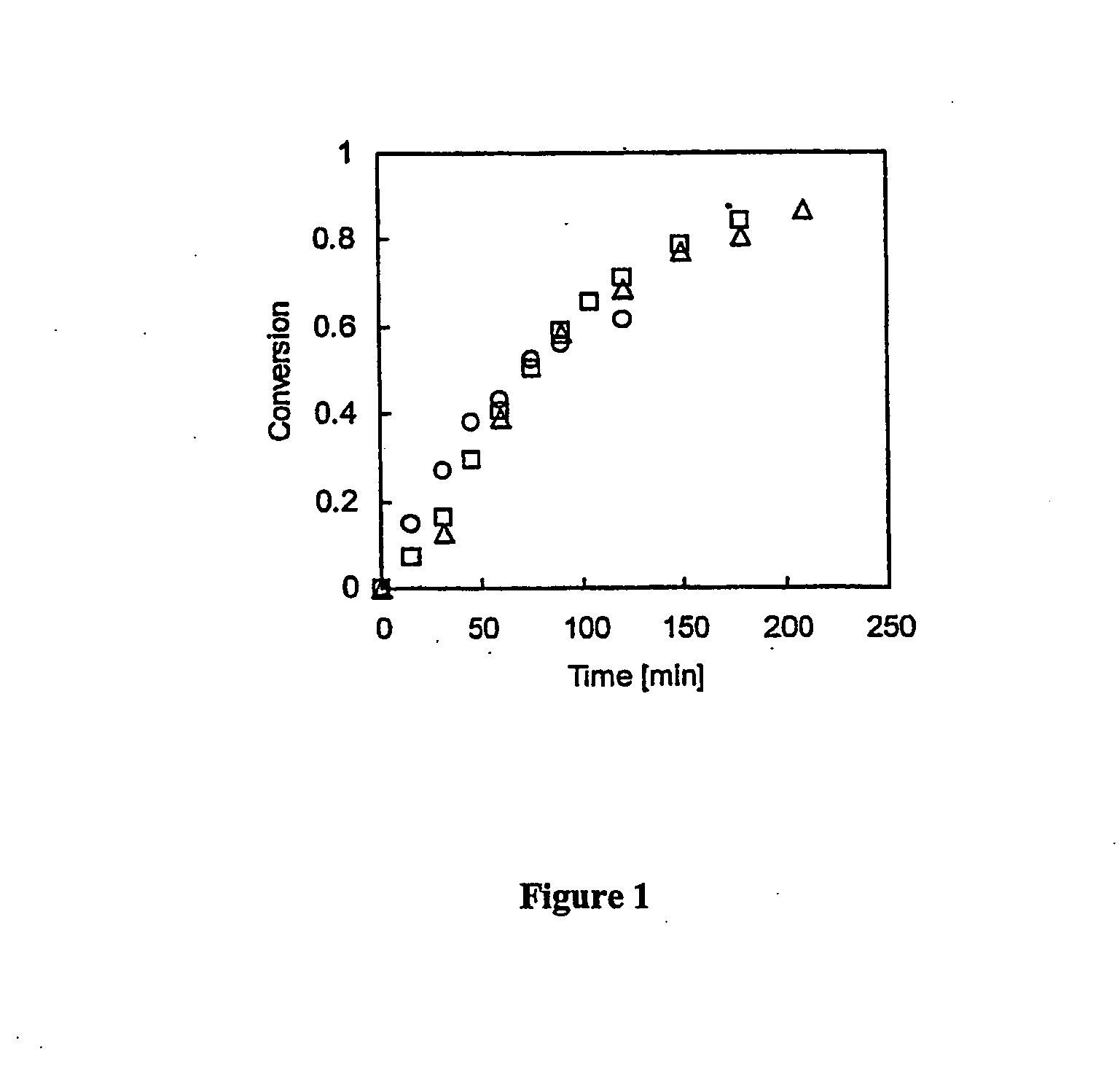Alpha, omega-allyl terminated linear poly(methacrylic acid) macromonomers for end-linked hydrogels and method of preparation
- Summary
- Abstract
- Description
- Claims
- Application Information
AI Technical Summary
Benefits of technology
Problems solved by technology
Method used
Image
Examples
example 1
Synthesis of α-allyl,ω-bromine Terminated Poly(t-BMA) Macromonomer via ATRP
[0075] CuBr (44.1 mg, 0.3 mmol) was added under argon to a dry round-bottom flask (rbf) equipped with a stirrer bar. The flask was sealed with a rubber septum, degassed and back-filled with argon three times and left under argon. Deoxygenated benzene (2.5 ml) and HMTETA (83.6 μL, 0.3 mmol) were added via argon-purged syringes and stirred until the copper (I) bromide-HMTETA complex was formed, as indicated by a change from a cloudy white suspension to a clear, colorless solution and then to a slightly greenish suspension Then t-BMA (5 ml, 30 mmol) and dodecane (0.2 ml, GC standard) were added under argon and the reaction vessel was placed in an oil bath maintained at 60° C. After the addition of ABIB (97.8 μL, 0.6 mmol), an initial sample was taken at time t=0 and the reaction was stirred until stirring stopped after about 90 minutes due to the formation of a very viscous dark green suspension. GC analysis sh...
example 2
Synthesis of α,ω-allyl Terminated Poly(t-BMA) Macromonomer
[0076] A small amount of benzene (2.5 ml) was injected into the round bottom flask to dissolve the macromonomer formed in the manner described in Example 1. Allyltributyltin (571 μL, 1.8 mmol) was then added, and the reaction mixture was heated for 13 hrs at 60° C. Acetone (5 ml) was added to stop the reaction. The reaction mixture was passed through a column of alumina to remove the copper-containing catalyst, and a 10-fold excess by volume of a mixture of MeOH / deionized water in equal parts by volume was added to the mixture, causing the α,ω-allyl terminated poly(t-BMA) macromonomer to precipitate. The precipitation procedure was repeated two times to remove residual monomer. The product macromonomer was formed as fine white powder and dried under vacuum overnight. The macromonomer was characterized by 1H NMR spectroscopy (CDCl3), which gave the following δ values: t-butyl —CH3 protons: 1.4-1.5 ppm; methacrylate α-CH3 prot...
example 3
Extension of Polymer Chains
[0077] A mixture containing a bromo-terminated poly(t-BMA) macromonomer having an allyl end group (Mn=7130, Mw / Mn=1.18, 0.7 g, 98 μmol) and copper (I) bromide (0.0148 g, 98 μmol) was added to a 50 mL round bottom flask, sealed with a rubber septum, degassed, and back-filled with argon three times. Deoxygenated t-BMA monomer (1.6 mL 9.8 mmol) and dodecane (GC standard 0.1 mL) were added via a purged syringe. The macromonomer was dissolved and HMTETA was introduced (26.8 μL, 98 μmol) to form the copper bromide-HMTETA complex as evidenced by the formation of a greenish cloudy suspension. A first sample was removed from the reaction mixture at time=0 and the round bottom flask was placed in an oil bath thermostated at 60° C. The reaction mixture was stirred for about 20 minutes, which led to the formation of a very viscous mixture which could not be stirred further. A second sample was removed from the reaction mixture. Comparison of a GC analysis of the firs...
PUM
| Property | Measurement | Unit |
|---|---|---|
| Temperature | aaaaa | aaaaa |
| Temperature | aaaaa | aaaaa |
| Wavelength | aaaaa | aaaaa |
Abstract
Description
Claims
Application Information
 Login to View More
Login to View More - R&D
- Intellectual Property
- Life Sciences
- Materials
- Tech Scout
- Unparalleled Data Quality
- Higher Quality Content
- 60% Fewer Hallucinations
Browse by: Latest US Patents, China's latest patents, Technical Efficacy Thesaurus, Application Domain, Technology Topic, Popular Technical Reports.
© 2025 PatSnap. All rights reserved.Legal|Privacy policy|Modern Slavery Act Transparency Statement|Sitemap|About US| Contact US: help@patsnap.com



